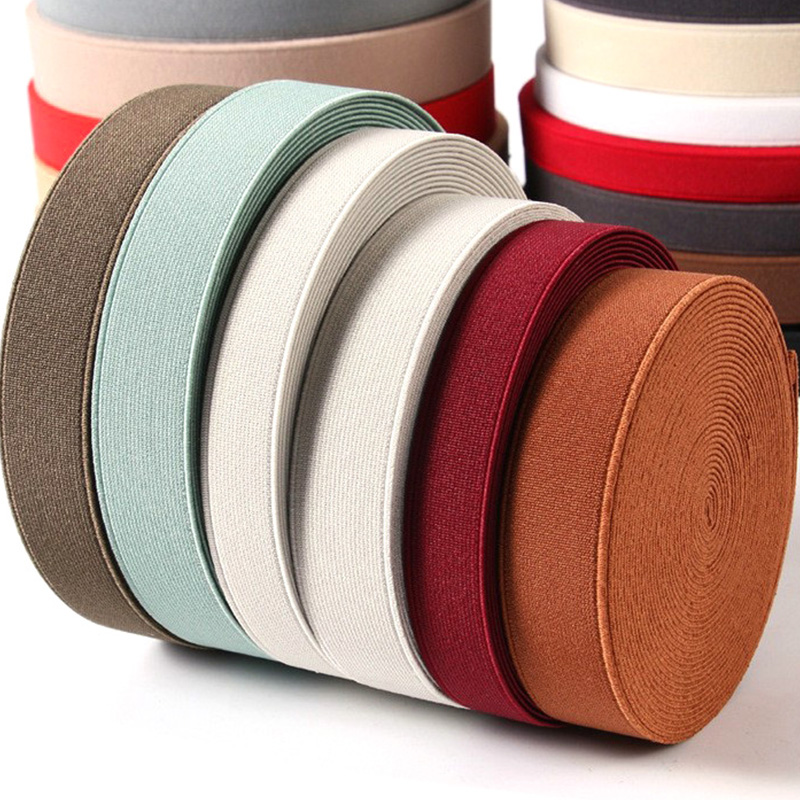Industry
 By Admin
By Admin
How Knitted Elastic Is Manufactured From Start To Finish
Knitted elastic is a versatile material widely used in various applications, from apparel waistbands to medical supplies. Understanding how knitted elastic is manufactured provides insight into the quality and functionality of the final product. This process involves several key steps, including yarn selection, elastic band weaving, knitting, finishing, and quality control. Each step plays a crucial role in producing elastic that meets the demands of different industries, including the growing use of bands for masks and decorative jacquard tape.

The process begins with the selection of raw materials. Elastic yarns, usually made from a blend of polyester or nylon with spandex or rubber cores, are chosen based on the elasticity and durability required. The quality of these yarns directly affects the comfort and stretch recovery of the knitted elastic. Once the yarns are prepared, the next stage involves elastic band weaving. Though knitting is the primary method for making knitted elastic, weaving techniques can also be applied for certain types of bands, especially those requiring specific textures or patterns.
Elastic band weaving involves interlacing yarns at right angles to create a flat and strong fabric. This method is often combined with knitting processes to enhance the stability of the elastic band. For example, bands used in masks often require a balance of flexibility and firmness, making elastic band weaving a suitable technique. Additionally, jacquard tape manufacturing sometimes uses weaving to produce intricate patterns that can be incorporated into elastic bands for aesthetic or branding purposes.
Following yarn preparation and any weaving, the knitting process begins. Specialized knitting machines create the knitted elastic by looping yarns together to form a stretchable fabric. This looped structure gives the elastic its characteristic flexibility and resilience. The knitting machines are capable of producing various widths and patterns, including those found in jacquard tape designs. Jacquard tape combines the functional stretch of elastic with decorative patterns, which makes it popular in fashion and accessory applications.
Knitted elastic for bands used in masks requires specific attention during manufacturing. These bands must maintain elasticity after repeated stretching and comply with health standards for comfort and safety. Therefore, the knitting process may be adjusted to produce a softer and more breathable band suitable for prolonged wear. Elastic band weaving techniques can be integrated to enhance strength without sacrificing flexibility, ensuring that mask bands fit securely yet comfortably.
After knitting, the elastic bands undergo finishing processes. These include heat setting, which stabilizes the shape and elasticity, and dyeing, where colors are added to meet design specifications. In the case of jacquard tape, finishing also involves setting the woven patterns so they retain their clarity and detail after repeated use. Finishing may also include coating or lamination for added durability or specific functional requirements, such as water resistance for certain elastic bands.
Quality control is an essential final step in the manufacture of knitted elastic. Samples are tested for stretchability, recovery, width consistency, and color fastness. For bands for masks, additional tests may check for skin-friendliness and breathability to ensure user comfort. Jacquard tape, often used in visible fashion elements, is inspected for pattern accuracy and color uniformity. The integration of elastic band weaving techniques adds complexity to quality checks but ensures that the final product meets functional and aesthetic expectations.
Throughout the production process, manufacturers must consider the end use of the elastic bands. Bands for masks have become an important product segment due to recent global health concerns, requiring elastic that is gentle on skin but firm enough to secure masks properly. Similarly, jacquard tape is gaining popularity as a decorative elastic band option, combining functionality with unique designs that enhance garment appeal. Even standard knitted elastic benefits from careful elastic band weaving and knitting methods to achieve the right balance of stretch and strength.
The manufacturing of knitted elastic is a blend of traditional techniques and modern machinery. While knitting remains the dominant method for producing stretchable bands, the role of elastic band weaving cannot be overlooked, especially for products demanding extra durability or decorative patterns. Bands for masks highlight how product-specific requirements influence manufacturing choices, with attention to comfort, durability, and compliance with health standards. Jacquard tape demonstrates how weaving and knitting intersect to produce elastic bands that serve both functional and aesthetic purposes.



 English
English Español
Español عربى
عربى Tiếng Việt
Tiếng Việt

